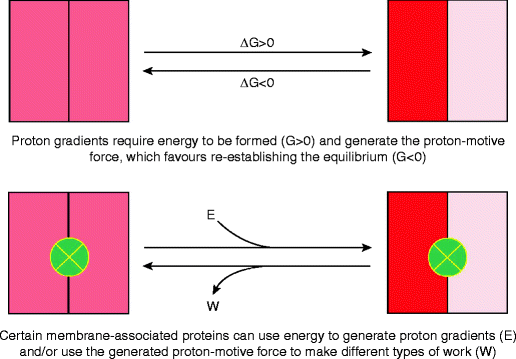However the mechanisms underlying the regulation of pmf in fluctuating light are not well known. In vertebrate animals brown fat tissues color is due to abundant blood vessels and capillaries.
 The Proton Motive Force Ppt Video Online Download
The Proton Motive Force Ppt Video Online Download
Proton motive force involved in protein transport across the outer membrane of Aeromonas salmonicida.

The proton motive force. A proton motive force can be tapped by protein complexes known as ATP synthases which are reverse-running proton pumps that allow protons to cross membranes but in a manner that the drive of these protons to move from regions of high proton concentration to regions of low proton concentration ie down their concentration gradient. Overview of Proton Motive Force. 246 Issue 4930 pp.
Basically this causes the cell to act like a tiny battery. Bacteria use these gradients for flagella and for the transportation of nutrients into the cell. In respiring bacteria under physiological conditions ATP synthase in general runs in the opposite direction.
The proton motive force pmf across the thylakoid membranes plays a key role for photosynthesis in fluctuating light. Group video project for Biology 1510 on how cells exploit the proton motive force to make ATP. ATP synthase produces ATP as protons flow across it proton motive force.
Mitochondria contain some of their own genes and can replicate independently of the cell via binary fission. Membrane potential in out G elect zF. See all Hide authors and affiliations.
KR Wong JT Buckley. A proton motive force is established via the action of either electron transport systems or instead membrane transport proteins that are known as proton pumps. Brown fat cells have a specialized protein that dissipates the proton-motive force across the mitochondrial membranes.
Department of Biochemistry and Microbiology University of Victoria BC Canada. In most cases the proton-motive force is generated by an electron transport chain which acts as a proton pump using the Gibbs free energy of redox reactions to pump protons hydrogen ions out across the membrane separating the charge across the membrane. The latter stimulated antibiotic uptake as determined using fluorescently labelled tobramycin in combination with flow cytometry analysis.
Chemicalcontribution G chem nRT ln H in H out n number of protons translocated p - 0059 V pH p - 017 - 003 - 020 V 2. This potential energy is used for the synthesis of ATP by oxidative phosphorylation or photophosphorylation respectively. What is the moving unitrotor composed of.
The proton motive force occurs when the cell membrane becomes energized due to electron transport reactions by the electron carriers embedded in it. This creates ATP while using the proton motive force created by the electron transport chain as a source of energy. The proton-motive force created by the pumping out of protons by the respiratory chain complexes is in the mitochondria of most tissues mainly used to translocate protons through the ATP synthase complex leading to the formation of ATP from adenosine diphosphate ADP and phosphate.
It promotes the movement of electrons against the electrochemical potential. White fat tissue on the other hand is specialized for fat storage and contains relatively few blood vessels or capillaries. The Protonmotive Force Protonmotive force p is the energy of the proton concentration gradient.
Overview A difference of solute concentration between two compartments separated by a biological membrane generates a tendency to equilibrium which in the case of protons is called proton motive force PMF. We can think of ATP synthase as consisting of a moving part and a stationary part. Proton-motive force can be generated by a variety of phenomena including the operation of an electron transport chain illumination of a PURPLE MEMBRANE and the hydrolysis of ATP by a proton ATPase.
What is unique about the mitochondria genetically. Biochemical and phenotypic assays indicated that 3-D cell conditioned medium stimulated the proton motive force PMF resulting in increased bacterial intracellular pH. In mitochondria energy released by the electron transport chain is used to move protons from the mitochondrial matrix N side to the intermembrane space P side.
Proton motive force is the force created by the transfer of protons or electrons across a membrane that can be used for chemical mechanical or osmotic processes. Proton motive force PMF is the force that promotes movement of protons across membranes downhill the electrochemical potential. The proton motive force will cause H ions to move down their electrochemical gradient and diffuse back into matrix This diffusion of protons is called chemiosmosis and is facilitated by the transmembrane enzyme ATP synthase As the H ions move through ATP synthase they trigger the molecular rotation of the enzyme synthesising ATP.
From Singleton Sainsbury Dictionary of Microbiology and Molecular Biology 2d ed p171 How to pronounce proton-motive force. An electrochemical gradient has two components. Science 03 Nov 1989.
What does the proton-motive force cause in terms of the active sites-it causes them to sequentially change functions as protons flow through the membrane-embedded component of the enzyme. Its energy can either be used right away to do work like power flagella or be stored for later in ATP. In mitochondria and chloroplasts proton gradients are used to generate a chemiosmotic potential that is also known as a proton motive force.